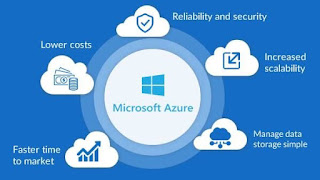Microsoft Azure Cloud Services:
Microsoft
Azure in Cloud Computing:
Microsoft Azure, formerly known as Windows Azure, is
Microsoft's public cloud computing platform. Azure is a public cloud computing
platform - it is Infrastructure as a Service (IaaS) and Platform as a Service
(PaaS) that can be used for information management, services such as analysis,
virtual computing, storage, network and much more.
It can be used to replace or complement your local
servers. Microsoft Azure is a cloud computing service created by Microsoft to
create, test, deploy and manage applications and services through data centers
managed by Microsoft.
How
to UseAzure cloud Services?
Create
and deploy:
1. Log in to the Azure portal.
2. Click Create a feature> Compute, and then
scroll down and click on Cloud Service.
3. In the new Cloud service panel, enter a value for
the DNS name.
4. Create a new resource group or select an existing
one.
5. Select a location Click on package.
6. Make sure that Start of deployment is selected.
Cloud Services is far from obsolete and the support
is available in the new portal, so it is safe to assume that it will not have
problems in the medium term use. The platform as a service (PaaS) is an
environment of implementation and development within the cloud that provides
cloud-based applications for complex, cloud-enabled applications.
The Azure application service is a platform as a
service that runs logical, mobile, API and business applications and
automatically manages the resources required by these applications. Get metrics
from the Azure application service to Visualize your performance.
Windows
Azure and Microsoft Azure Difference:
Microsoft has released Windows Azure in 2010 and
changed the name of Microsoft Azure in 2014. So, in practical terms, they are
the same network, only with different names. The change was a brand effort by
Microsoft to mark Azure as a public cloud platform for its customers. Microsoft
Azure, formerly known as Windows Azure, is Microsoft's public cloud computing
platform.
It provides a range of cloud services, including
those for computing, analysis, storage and network. Azure has created
tremendous success for Microsoft as a global cloud-based system that stands out
in the integration of several services, including PaaS (Platform as a Service),
IaaS (Infrastructure as a Service) and SaaS (Software as a Service). It is also
very flexible, which makes it easy for developers and engineers of any
experience to work with it.
Azure
for DR and backup:
As they can do with other public cloud platforms,
some organizations use Azure for backup of data and disaster recovery (DR). In
addition, some organizations use Azure as an alternative to their own data
center. Instead of investing in local servers and storage, these organizations
choose to run some or all of the commercial applications in Azure.
To ensure availability, Microsoft has Azure
datacenters located throughout the world. As of July 2018, Microsoft Azure
services are available in 54 regions, spread across 140 countries. Since not
all services are available in all regions, Azure users must ensure that
workload and data storage locations meet all compliance requirements or other
applicable legislation.
Benefits:
The benefits of the cloud are well documented:
generating virtual machines in minutes, providing scalable and durable cloud
storage and backup and recovery solutions for businesses of all sizes. However,
not all cloud solutions are created equal. Here are four reasons why more
companies are choosing Microsoft Azure.
For More info click this link: Microsoft azureonline training.

Hi, Great.. Tutorial is just awesome..It is really helpful for a newbie like me..
ReplyDeleteI am a regular follower of your blog. Really very informative post you shared here. Kindly keep blogging
Python Training in Chennai | Certification | Online Course Training | Python Training in Bangalore | Certification | Online Course Training | Python Training in Hyderabad | Certification | Online Course Training | Python Training in Coimbatore | Certification | Online Course Training | Python Training in Online | Certification | Online Course Training
I am really happy to say it’s an interesting post to read . I learn new information from your article , you are doing a great
ReplyDeletejob . Keep it up
Java training in Chennai | Certification | Online Course Training | Java training in Bangalore | Certification | Online Course Training | Java training in Hyderabad | Certification | Online Course Training | Java training in Coimbatore | Certification | Online Course Training | Java training in Online | Certification | Online Course Training
It would have been the happiest moment for you,I mean if we have been waiting for something to happen and when it happens we forgot all hardwork and wait for getting that happened. great work...good luck for ur next post..
ReplyDeleteAWS training in Chennai | Certification | AWS Online Training Course | AWS training in Bangalore | Certification | AWS Online Training Course | AWS training in Hyderabad | Certification | AWS Online Training Course | AWS training in Coimbatore | Certification | AWS Online Training Course | AWS training | Certification | AWS Online Training Course